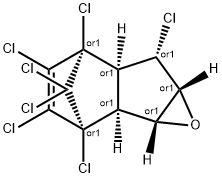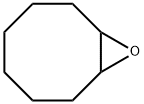Heptachlor exo-epoxide , Analysis standard , 1024-57-3
Synonym(s):
endo-1,4,5,6,7,8,8-Heptachloro-2,3-epoxy-4,7-methano-3a,4,7,7a-tetrahydroindane
CAS NO.:1024-57-3
Empirical Formula: C10H5Cl7O
Molecular Weight: 389.32
MDL number: MFCD01311793
EINECS: 213-831-0
| Pack Size | Price | Stock | Quantity |
| 10MG | RMB239.20 | In Stock |
|
| others | Enquire |
PRODUCT Properties
| Melting point: | 160-161.5℃ |
| Boiling point: | 503.92°C (rough estimate) |
| Density | 1.7335 (rough estimate) |
| vapor pressure | 2.6(x 10-6 mmHg) at 20 °C (IARC, 1974)300(x 10-6 mmHg) at 30 °C (Nash, 1983) |
| refractive index | 1.5000 (estimate) |
| Flash point: | 11 °C |
| storage temp. | APPROX 4°C |
| solubility | Chloroform (Slightly), Ethyl Acetate (Slightly), Methanol (Slightly) |
| form | Solid |
| color | White to off-white |
| Water Solubility | (μg/L): 350 at 25–29 °C (Park and Bruce, 1968) 275 at 25 °C (quoted, Warner et al., 1987) |
| Henry's Law Constant | 0.59(x 10-5 atm?m3/mol) at 5 °C, 0.84 at 15 °C, 1.48 at 20 °C, 2.27 at 25 °C, 3.26 at 35 °C:in 3% NaCl solution: 2.07
at 5 °C, 4.93 at 15 °C, 7.70 at 25 °C, 9.28 at 35 °C (gas stripping-GC, Cetin et al., 2006) |
| Exposure limits | ACGIH TLV: TWA 0.05 mg/m3 (adopted). |
| Stability: | Light Sensitive |
| EPA Substance Registry System | Heptachlor epoxide (1024-57-3) |
Description and Uses
Like pure heptachlor, heptachlor epoxide is awhite powder that does not explode easily. Heptachlor epox-ide is an oxidation product of heptachlor formed by plantsand animals, including humans, after exposure to heptachlor.About 20% of heptachlor is changed within hours intoheptachlor epoxide in the environment and in the body. It isalso present as acontaminant in heptachlor. It was notmanufactured and was not usedas an insecticide likeheptachlor. Molecular weight = 389.30; Freezing/Meltingpoint= 160- 162℃. Hazard Identification (based on NFPA-704 M Rating System): Health 3, Flammability 1, Reactivity0. Soluble in water.
The cis-metabolite of organochlorine pesticide Heptachlor.
Safety
| Symbol(GHS) |    GHS06,GHS08,GHS09 |
| Signal word | Danger |
| Hazard statements | H300-H351-H373-H410 |
| Precautionary statements | P202-P260-P264-P270-P273-P301+P310 |
| Hazard Codes | T,N,F |
| Risk Statements | 25-33-40-50/53-39/23/24/25-23/24/25-11-52/53 |
| Safety Statements | 36/37-45-60-61-16-7 |
| RIDADR | 2761 |
| WGK Germany | 3 |
| RTECS | PB9450000 |
| HazardClass | 6.1(a) |
| PackingGroup | II |
| Hazardous Substances Data | 1024-57-3(Hazardous Substances Data) |
| Toxicity | Acute oral LD50 for rats 47 mg/kg (RTECS, 1985) |


